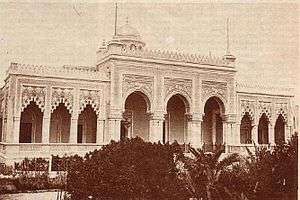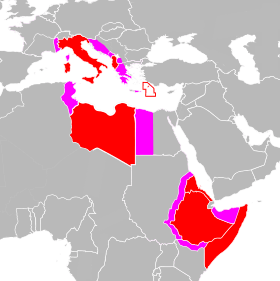Italian Cyrenaica
| Italian Cyrenaica | ||||||||||
| Cirenaica Italiana | ||||||||||
| ||||||||||
| ||||||||||
| Capital | Benghazi | |||||||||
| Languages | Italian Arabic | |||||||||
| Religion | Islam Roman Catholicism | |||||||||
| Government | Colony | |||||||||
| Historical era | Interwar period | |||||||||
| • | Established | 1927 | ||||||||
| • | Disestablished | 1934 | ||||||||
| ||||||||||

Italian Cyrenaica was an Italian colony, located in present-day eastern Libya, that existed from 1927 to 1934. It was part of the Italian North African territory conquered from the Ottoman Empire in 1911.
History
Italian Cyrenaica was formed in 1927, after it and Italian Tripolitania became independent colonial entities within Italian North Africa. In 1934, Italian Cyrenaica became part of Italian Libya.
In the 1920s, Cyrenaica was the scene of fighting between Italian colonial forces and Libyan rebels who were fighting for independence from colonial rule. In 1931, the rebel independence leader Omar Mukhtar was captured and executed.
Cyrenaica was populated by more than 20,000 Italian colonists in the late 1930s, mainly around the coast. As a consequence there was a large economic development effort in the second half of the 1930s. Italy did massive investment in the infrastructure of Libya but the purpose was to develop the economy for the benefit of Italy.[1]
The Italian aim was to drive the local population to the marginal land in the interior and to resettle the Italian population in the most fertile lands of Libya.[1] The Italians did not provide the Libyans with adequate education, the Italian population (about 10% of the total population) had 81 elementary schools in 1939-1940, while the Libyans (more than 85% of total population) had 97.[1]
In Cirenaica were founded -for the Italian colonists- the rural villages of Baracca, Maddalena, Oberdan, D’Annunzio and Battisti in 1938, successively Mameli and Filzi in 1939. For Libyan families (who contributed with many soldiers enrolled in the two Italian-Libyan Divisions: 1st Libyan Division Sibelle and 2 Libyan Division Pescatori) were created in Cyrenaica the villages of Gedida-Nuova, Nahida-Risorta, Zahra- Fiorita and el-Fager-Alba.
Italian concentration camps in Cyrenaica

Fascist Italy maintained several concentration camps in Eastern Libya during the first phase of its occupation of that country. The colonial administration began in 1929 the nearly wholesale deportation of the people of the Jebel Akhdar to deny the rebels the support of the local population. The forced migration of more than 100,000 people ended in concentration camps in Suluq, El Magrun, Abyar and El Agheila where tens of thousands died in squalid conditions, mainly because of epidemics like the Spanish flu.The concentration camps were dismantled after 1934, when the fascist regime obtained full control of the area and started a policy of assimilation of the local Arab community. This policy was so successful that in 1940 there were two Italian colonial division made of Libyans.
Infrastructure

The Italians implemented major infrastructure projects in Italian Cyrenaica, mainly in the 1930s; the most important were the coastal road between Tripoli and Benghazi, the railways Benghazi-Barce and Benghazi-Soluch, and the enlargement of the Port of Benghazi.
A group of villages with all the needed communications (and infrastructures) for Italians and Libyans were established in coastal Cyrenaica during the 1930s.[2]
Main military and political developments
- 1911: Beginning of the Italo-Turkish War. Italian conquest of Tobruk, Derna, and Benghazi.[3]
- 1912: Treaty of Lausanne ends the Italo-Turkish war. Ottoman empire ceded Tripolitania and Cyrenaica.[3]
- 1917-21: Series of agreements (signed at Acroma, Ar Rajma, Bu Mariam respectively) between Italians and Senussis, led by Sayyid Idris, resulted in the postponement of conflict.[4]
- 1923: Italian governor, Luigi Bongiovanni declares the cancellation of treaties with Senussis, and Italian forces occupy Ajdabiya, capital of the Senussi emirate, launching the reconquest of Cyrenaica.[5] Senussi resistance led by Omar Mukhtar begins.
- 1925: Italo-Egyptian treaty defines the Cyrenaican (later Libyan)-Egyptian border.[6]
- 1926: Conquest of Al-Jaghbub.[3]
- Winter 1927-8: Launching the "29th Parallel line operations", as a result of coordination between the governments of Tripolitania and Cyrenaica, led to the conquest of gulf of Sidra, and linking the two colonies.[7]
- 1929: Pietro Badoglio becomes a unique governor of Tripolitania and Cyrenaica. Beginning of Sidi Rhuma talks with Omar Mukhtar, but they failed eventually.[3]
- 1931: Occupying of Kufra Oases, constructing the barbed wire on the Libyan-Egyptian border, the capture, and then the execution of Omar Mukhtar.[5]
- 1932: Badoglio declares the end of Libyan resistance.[3]
- 1934: Cyrenaica is incorporated in Colony of Libya.
Notes
- 1 2 3 General History of Africa, Albert Adu Boahen,Unesco. International Scientific Committee for the Drafting of a General History of Africa, page 196, 1990
- ↑ (Italian) Chapter Libya-Cyrenaica
- 1 2 3 4 5 Kalifa Tillisi, “Mu’jam Ma’arik Al Jihad fi Libia1911-1931”, Dar Ath Thaqafa, Beirut, Lebanon, 1973.
- ↑ Mohammed Fouad Shukri, “As Senussiya Deen wa Daula”, Markaz ad Dirasat al Libiya, Oxford, 2005.
- 1 2 Rodolfo Graziani, "Cirenaica Pacificata", translated by: Mohammed Bashir el Ferjani, Al Ferjani publishing, Tripoli-Libya.
- ↑ Jean Pichon, "La Question de Libye dans la Règlement de La Paix", translated by Ali Dhawwi, Markaz Jihad al Libiyeen lid Dirasat at Tarikhiya, Tripoli-Libya, 1991.
- ↑ Attilio Teruzzi, "Cirenaica Verdi", translated by Kalifa Tillisi, ad Dar al Arabiya lil Kitab, 1991.
Bibliography
- Chapin Metz, Hellen. Libya: A Country Study. Washington: GPO for the Library of Congress, 1987.
- Sarti, Durand. The Ax within: Italian Fascism in Action. Modern Viewpoints. New York, 1974.
See also
| Wikimedia Commons has media related to Italian Cyrenaica. |
- List of colonial governors of Cyrenaica
- Italian Libya
- Italian Libya Railways
- Italo-Libyans
- Italian concentration camps in Libya
- Jebel Akhdar Mountains
- Benghazi Province
.svg.png)


